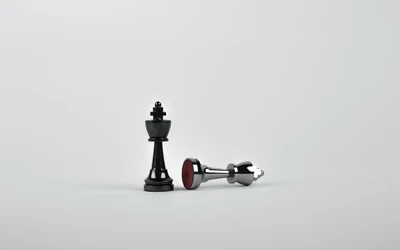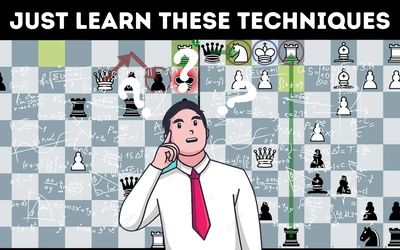
7 MOST COMMON Chess Mistakes
The seven most common mistakes plaguing players of all levels, illuminating a path towards strategic enlightenment.Ladies and gentlemen, when you first begin your chess career, you are going to make a lot of mistakes. When you research the most common types of mistakes that beginners and intermediate-level players make, you'll hear things like "you hang your queen too much," "you don't develop your pieces," or "you don't focus on the center." In this article, I am going to go above and beyond that by far. I will give you what, in my opinion, are the seven most important mistakes that you are making that are preventing you from gaining Elo consistently.
Mistake 1: Trading Everything
When you're trading pieces in chess, there are multiple elements to consider. Trading pieces isn't just about swapping material; it needs to be done strategically. For instance, in the Scotch Opening (1.e4 e5 2.Nf3 Nc6 3.d4 exd4 4.Nxd4), Black should not just aim to trade pieces but should focus on development and maintaining tension. A move like 4...Nxd4 isn't great because it removes a key piece that should be putting pressure on White's center.
Trading queens early can also be problematic unless it fits your strategic goals. For example, after 1.e4 e5 2.Nf3 Nc6 3.d4 exd4 4.Nxd4 Nxd4 5.Qxd4, White can lose momentum if Black develops pieces with tempo.
In short, don't just trade pieces aimlessly. Each trade should have a concrete reason, such as gaining a strategic advantage or improving your piece placement.
Mistake 2: Fake Training
Fake training is the art of convincing yourself you are doing productive, legitimate things to improve at chess when you aren't. This could be buying courses and only studying them halfway or playing blitz games without any real analysis or learning. It's crucial to set aside dedicated time to thoroughly study and understand openings, tactics, and endgames.
For example, if you buy an e4 course and learn the Vienna Game, you should be able to explain the main ideas and variations, such as the Vienna Gambit, without needing to look it up. The same applies to practicing tactics; it's not enough to solve puzzles mindlessly. You need to internalize the patterns and be able to recognize them in your games.
Mistake 3: One-Movers
One-movers are moves that create simplistic threats without considering the opponent's responses or the overall position. Avoid making moves that create one-move threats without a deeper understanding of the position. Always consider your opponent's best responses and aim to make moves that improve your position strategically.
Let's move to mistake number four...
Mistake 4: Repeating the Same Errors
This mistake encompasses the frustrating experience of repeating the same errors in your chess games without making the necessary adjustments. It can manifest in various ways, including poor opening choices, tactical oversights, or strategic misunderstandings. Here’s a breakdown of how this might happen and how you can address it.
- Inconsistent Opening Play:
- Example: Consider a player like Lucy, who frequently plays 1.e4 but hasn’t fully reviewed or understood the Vienna Game. Despite obtaining advantageous positions, she often makes suboptimal moves, such as 3. Nf3 instead of the correct move in a given line.
- Solution: To improve, you need to consistently review your opening repertoire. Study the main lines and typical tactics associated with your chosen openings. Use resources like opening databases and instructional videos to deepen your understanding.
- Tactical Mistakes:
- Example: A common error is hanging your queen or other pieces. It’s easy to overlook threats, especially when you're focused on your own plans.
- Solution: Develop a habit of checking for threats on every move. Before making a move, look for checks, captures, and threats from your opponent. Tools like tactical puzzles and training exercises can help sharpen your awareness.
- Failing to Punish Opponent’s Mistakes:
- Example: In the Scandinavian Defense, if your opponent repeatedly misplaces their pieces, you must learn how to capitalize on those mistakes. For instance, if they allow a piece to be pinned or fail to castle, you should be ready to exploit these weaknesses.
- Solution: Review your games and identify missed opportunities. Use analysis tools to see where you could have punished your opponent’s errors more effectively. Practicing these scenarios in a controlled environment, like training games or analysis sessions, can help.
- Strategic Misunderstandings:
- Example: Misjudging an exchange or failing to recognize a strong positional move can cost you the game. For instance, exchanging a well-placed knight for a less active bishop without a good reason can weaken your position.
- Solution: Study classical games and learn from the masters. Pay attention to how they handle different strategic situations. Books and lectures on chess strategy can provide valuable insights.
Practical Steps to Address Repeated Mistakes
- Consistent Review: Regularly review your games to identify recurring mistakes. Use a chess engine to analyze critical positions and understand what went wrong.
- Focused Practice: Work on specific areas of weakness. If you often blunder pieces, spend extra time on tactical training. If your openings are weak, devote time to studying opening theory.
- Setting Goals: Set specific, achievable goals for each aspect of your game. For example, aim to learn a new opening line thoroughly or to complete a certain number of tactical puzzles each week.
- Mental Discipline: Cultivate the habit of double-checking your moves and considering your opponent’s threats. Mindfulness techniques and mental exercises can help improve your focus and reduce blunders.
By addressing these recurring mistakes with targeted practice and consistent review, you can break the cycle and start making progress in your chess journey.
Mistake 5: Time Management
When thinking about time management in chess, most players focus on either playing too slowly and losing on time or playing too quickly and making blunders. Effective time management is about finding a balance between these extremes. Here are key points to consider:
- Set Time Goals: In shorter time controls, avoid trailing your opponent by more than 20 seconds. This prevents you from getting into a time scramble where you might panic and make poor decisions.
- Use Time Efficiently: In longer games, don’t play too fast. For example, if you're playing a 30-minute game and still have 28 minutes left by move 25, you're not using your time effectively. Conversely, in shorter games like 3-minute blitz, don't overthink; make solid, quick moves.
- Strategic Thinking: When unsure, make simple, non-committal moves that improve your position without significantly changing the dynamics. Moves like a3 or h3 in unclear positions can be useful.
- Practice with Time Constraints: To improve, practice setting specific time constraints for your moves. For instance, in a 10-minute game, decide to move within 10-15 seconds unless the position is critical.
- Endgame Awareness: In endgames, prioritize efficient use of time. Focus on key strategies like advancing your pawns, activating your king, and creating clear plans to convert your advantage.
Example
In a game where a player named Eric was up in material and position, he ended up losing because he mismanaged his time. With low time on the clock, he made rushed moves that allowed his opponent to counter-attack and win. Proper time management could have helped him calmly convert his advantage by focusing on key tactical threats and maintaining control.
Mistake 6: Selfish Brain
The concept of the "selfish brain" in chess refers to a player's tendency to focus only on their own plans and moves without considering the opponent's ideas and threats. Overcoming this mistake involves:
- Constant Evaluation: Always ask yourself what your opponent wants to achieve with their last move. Consider their threats and plans before making your own move.
- Opponent’s Perspective: Put yourself in your opponent's shoes. Think about what moves you would make if you were in their position. This helps you anticipate their strategies and prepare countermeasures.
- Tactical Awareness: Draw arrows or visualize lines from your opponent’s pieces to your own. This helps you see potential threats like forks, pins, and skewers that might otherwise be missed.
- Holistic Thinking: Don't just focus on your attacking ideas. Balance your play by considering both your offensive and defensive responsibilities. Ensure your king is safe and your pieces are well-coordinated.
- Pattern Recognition: Train regularly with tactics puzzles to improve your ability to quickly spot both your own tactical opportunities and those of your opponent.
Example
In a game where a player goes for an all-out attack without considering the opponent's counter-attack, they often find themselves losing to a simple tactic or a mating net they overlooked. For instance, focusing on attacking on the queenside while ignoring a potential mate threat on the kingside can lead to a swift defeat. Always be aware of both sides of the board and the potential threats your opponent can pose.
Mistake 7: Tunnel Vision
Tunnel vision in chess refers to the tendency to focus excessively on a specific plan or idea while neglecting alternative strategies or the broader aspects of the position. Overcoming tunnel vision involves developing a more flexible and dynamic approach to the game. Here are key points to consider:
- Stay Flexible: Avoid becoming fixated on a single plan. Continuously reassess the position and be willing to adapt your strategy based on changing circumstances.
- Consider Alternatives: Always explore multiple candidate moves before making a decision. Train yourself to look for different possibilities, even if your initial plan seems promising.
- Evaluate Risk: Assess the potential drawbacks and risks associated with your chosen plan. Consider whether your opponent has any tactical resources or counterplay that could undermine your strategy.
- Controlled Aggression: While it's important to play actively and seek opportunities, be cautious about overextending or committing to overly aggressive plans without proper justification.
- Maintain Objectivity: Try to view the position objectively, without allowing emotions or preconceived notions to cloud your judgment. Stay open-minded and receptive to new ideas.
Example
Imagine a player who becomes fixated on launching a kingside pawn storm, neglecting the weaknesses in their own position or failing to notice a tactical opportunity on the opposite wing. As a result, they may miss a critical defensive resource from their opponent or overlook a stronger continuation that leads to a more favorable outcome. By maintaining a broader perspective and considering alternative plans, they could have navigated the position more effectively.
Finally
In conclusion, avoiding tunnel vision is essential for success in chess. By remaining flexible, considering alternatives, evaluating risks, exercising controlled aggression, and maintaining objectivity, players can enhance their decision-making process and improve their overall performance on the board. Overcoming tunnel vision requires discipline, patience, and a willingness to explore different possibilities, but the rewards include greater resilience, adaptability, and a deeper understanding of the game. By incorporating these principles into their approach, players can minimize the impact of Mistake 7 and elevate their game to new heights.
More blog posts by Millionaire_19

Is Bullet Chess Good or Bad for Your Growth?
What is Bullet? It's just 1 minute per side for the player to test his ultimate speed and nerves.
What If Magnus Carlsen Played Bobby Fischer?
Chess fans have always enjoyed speculating about fantasy matchups between legendary players from dif…
Top 10 Middlegame Tips for Everyone
It's always good to know some theory that can result in getting better positions in the middle game,…